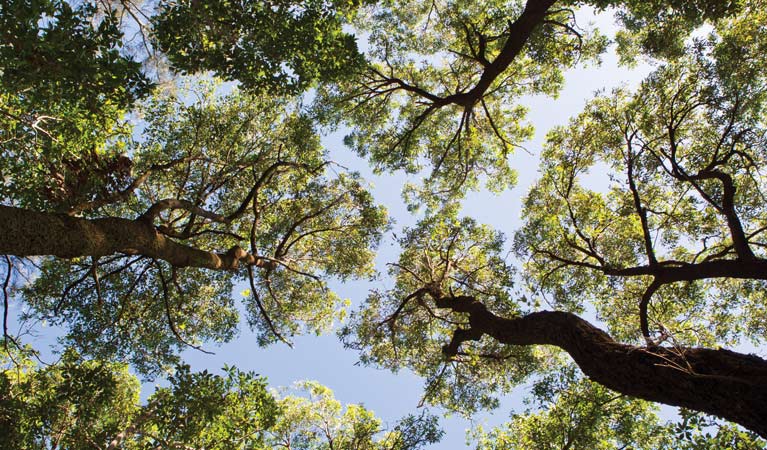Coffs Coast Regional Park
Overview
Coffs Coast Regional Park, near Coffs Harbour, is a top spot for fishing, surfing and birdwatching. You’ll find great picnic areas, plus beaches with off-leash dog zones.
Read more about Coffs Coast Regional Park
It’s easy to experience an endless summer at Coffs Coast Regional Park. Lose yourself in its string of pristine beaches which together offer everything from unbeatable surf and safe swimming to picnic areas and children’s playgrounds.
Explore undulating dunes, rainforest pockets, tranquil lakes, inviting parklands and charming coastal towns along the coastal walk and discover majestic headlands ideal for whale watching and taking in sweeping views of Solitary Islands Marine Park.
Take your pick of outdoor activities – either in the water or along the waterfront. Go fishing, birdwatching or bodyboarding, take your dog for a walk, or find the perfect picnic spot for a memorable family barbecue.
Local alerts
For the latest updates on fires, closures and other alerts in this area, see https://www.nationalparks.nsw.gov.au/visit-a-park/parks/coffs-coast-regional-park/local-alerts
Map
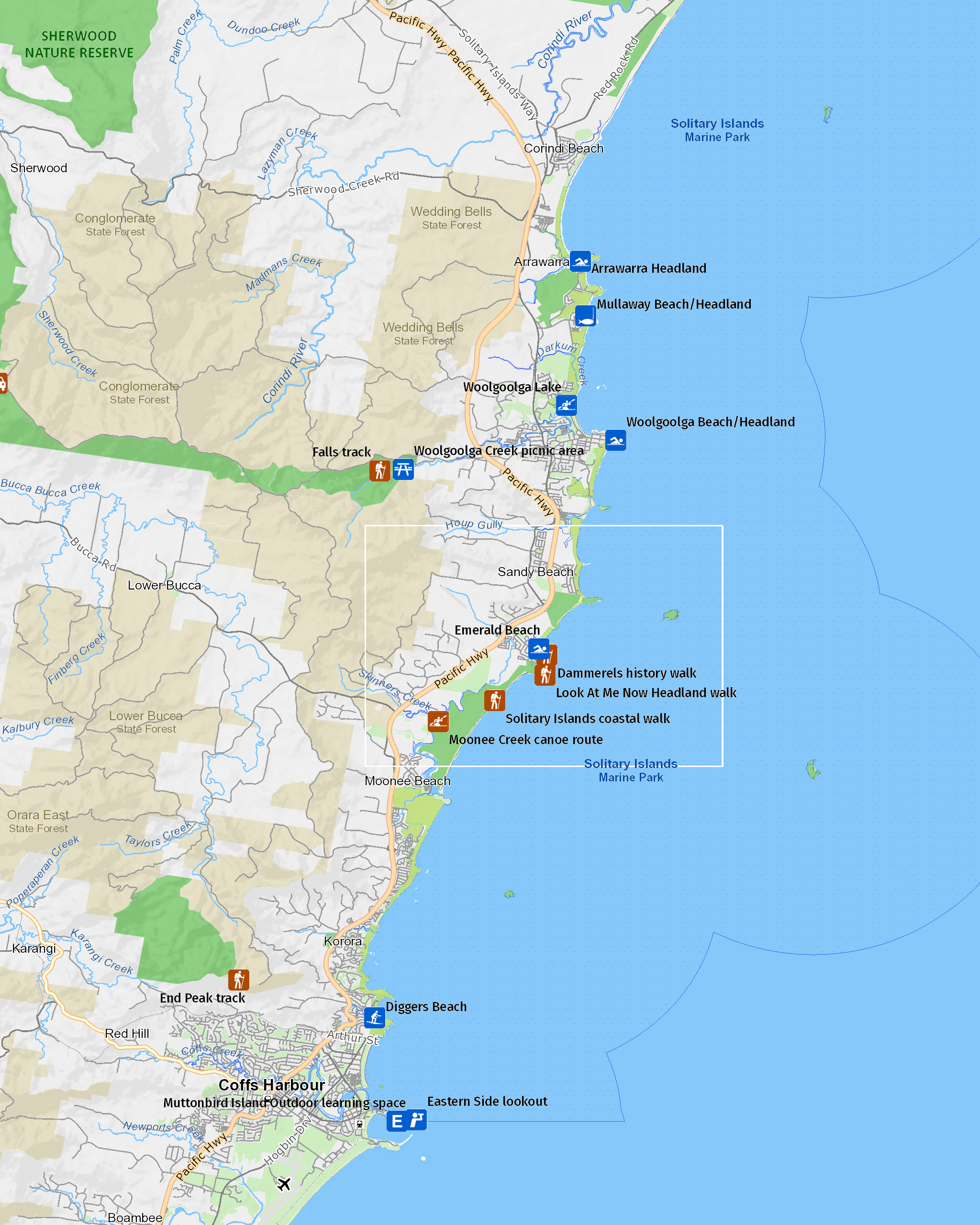
Map
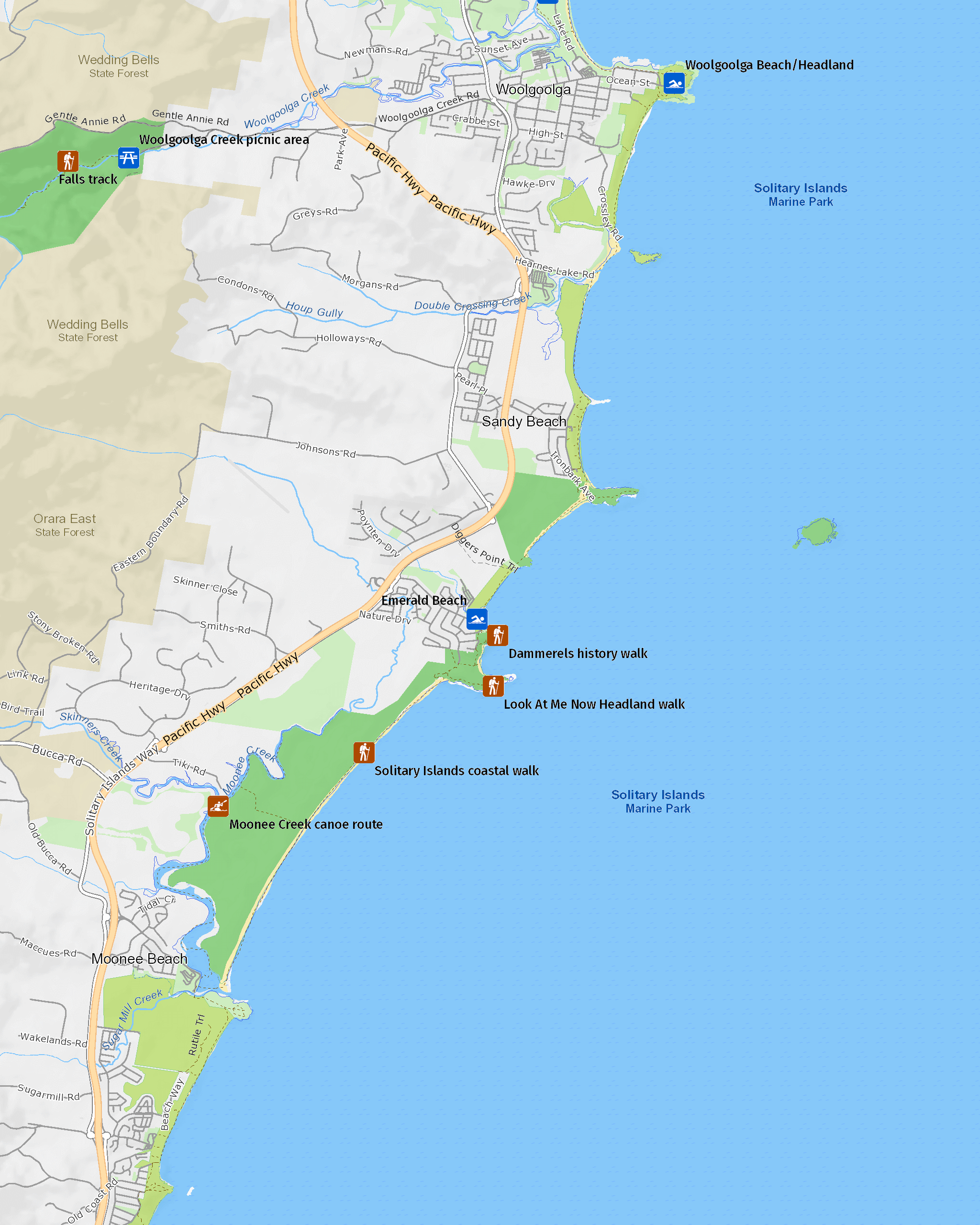
Map legend

Contact
- in the North Coast region
Coffs Coast Regional Park is always open but may have to close at times due to poor weather or fire danger.
-
-
Coffs Harbour office
02 6652 0900
Contact hours: Monday to Friday, 8.30am to 4.30pm. - 4/32 Edgar St, Coffs Harbour NSW 2450
-
Email: npws.coffscoast@environment.nsw.gov.au
-
Coffs Harbour office
Visitor info
All the practical information you need to know about Coffs Coast Regional Park.
Getting there and parking
Get driving directions
Coffs Coast Regional Park is accessible in several places from the Pacific Highway. Diggers, Beach Arrawarra, and Woolgoolga are the largest sections of the park.
Parking Show more
- Arrawarra Headland See on map
- Diggers Beach See on map
- Mullaway Beach and Headland See on map
- Woolgoolga Beach and Headland See on map
- Woolgoolga Lake See on map
By bike
Check out the Bicycle information for NSW website for more information
Best times to visit
Spring
Head to one of the Park's headlands for stunning coastal views and to watch whales.
Summer
The beaches of the park are your playground - go swimming surfing, snorkling and more.
Winter
A great time to walk the Solitary Islands coastal walk.
Weather, temperature and rainfall
Summer temperature
Average
17°C and 29°C
Winter temperature
Average
5°C and 20°C
Rainfall
Wettest month
March
Driest month
August
The area’s highest recorded rainfall in one day
388.2mm
Facilities
Amenities
Toilets
- Arrawarra Headland
- Diggers Beach
- Emerald Beach
- Mullaway Beach and Headland
- Woolgoolga Beach and Headland
Picnic tables Show more
- Arrawarra Headland
- Diggers Beach
- Emerald Beach
- Mullaway Beach and Headland
- Woolgoolga Beach and Headland
- Woolgoolga Lake
Barbecue facilities Show more
Boat ramp
Drinking water
Public phone
Showers
Maps and downloads
Permitted
Pets
Pets and domestic animals are permitted in some areas of this park.
The following areas allow dog walking:
- Hearns Lake Beach (Woolgoolga)
- Darkum Beach (Woolgoolga North)
- Corindi/Pipe Clay Beach (Arrawarra North)
- Emerald Beach, north of Fiddamans Creek and south of Diggers Head.
- Woolgoolga Back Beach
- Woolgoolga Lake
Certified assistance animals are allowed in all areas of this park. Find out which regional parks allow dog walking and see the OEH pets in parks policy for more information.
Prohibited
Smoking
NSW national parks are no smoking areas.
Nearby towns
Woolgoolga (1 km)
Woolgoolga is a busy rural service town with a large Sikh population. It features a coastal setting surrounded by banana farms and forested hills.
Coffs Harbour (19 km)
Coffs Harbour is a coastal city on the North Coast, packed with things to do. It's surrounded by lush forests and national parks.
Bellingen (54 km)
Bellingen is a laid-back, tree-lined town with a New Age vibe. It's set in a luxuriant valley beside the Bellinger River.
Learn more
Coffs Coast Regional Park is a special place. Here are just some of the reasons why:
Whale watchers
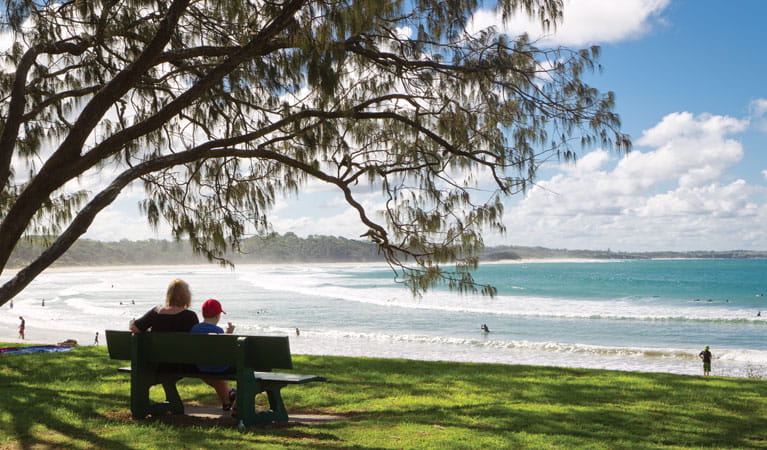
Coffs Coast Regional Park is a fantastic place to enjoy watching these majestic creatures on their long coastal journey. Look-At-Me-Now Headland near Emerald Beach is a great vantage point, but locals agree Woolgoolga Headland is your best bet for glimpsing humpbacks. In fact, it’s also known as ‘Whale Watch Headland’. Plan a trip between June and October to see this inspiring sight.
- Whale watching at Woolgoolga Join our NPWS guides for a free whale watching experience on the Coffs Coast. It's whale watching season – see how many whales you can spot out deep! Great for all ages.
- Woolgoolga Beach and Headland Woolgoolga Beach and Headland has the best whale watching in the Coffs Region, plus great surfing, fishing and picnics and scenic views.
Life’s a beach
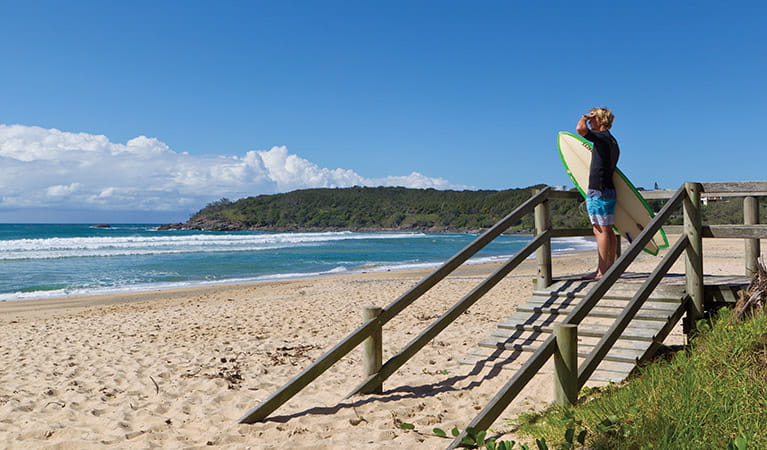
Golden beaches are the park’s premier attraction. Here, everything revolves around the water – whether you’re swimming and surfing in it, or walking and fishing beside it. Spend your days discovering the headland walking tracks, boat ramps, parklands and playgrounds. And no matter where you go, you’re bound to find a perfect spot for a beachside picnic. There are also plenty of dog-friendly areas at Coffs Coast Regional Park – just another of its popular features. Take your dog for a walk along one of the coastal paths, plus, there are several beaches with leash-free zones, meaning your pooch can zip about and enjoy the sand and sea as much as you do. The leash-free area around Corindi and Pipeclay beaches is a local favourite.
- Arrawarra Headland Soak up views of Solitary Islands Marine Park from Arrawarra Headland and Beach near Coffs Harbour. Fishing, surfing, swimming – it’s all here waiting for you to enjoy.
- Diggers Beach Located opposite the Big Banana in Coffs Harbour, Diggers Beach is excellent for surfing and learning to surf, plus fishing, swimming, birdwatching and beach walking.
- Emerald Beach Positioned near Look-at-me-now Headland, 20km from Coffs Harbour, Emerald Beach is a local surfing hotspot. Visit also for fishing or swimming, or for barbecues in the picnic area.
- Mullaway Beach and Headland Head south from Arrawarra to discover beautiful Mullaway Headland and Beach, near Coffs Harbour. Make the most of its picnic area and barbecues, go fishing or swimming.
Plants and animals protected in this park
Animals
-

White-bellied sea eagle (Haliaeetus leucogaster)
White-bellied sea eagles can be easily identified by their white tail and dark grey wings. These raptors are often spotted cruising the coastal breezes throughout Australia, and make for some scenic bird watching. Powerful Australian birds of prey, they are known to mate for life, and return each year to the same nest to breed.
-
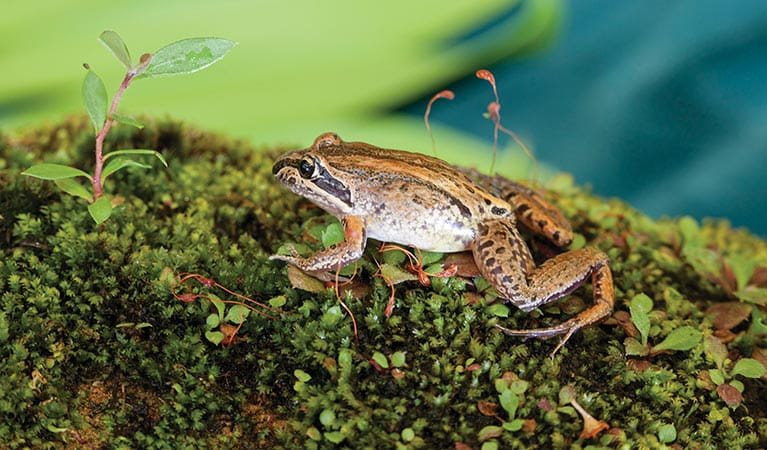
Brown-striped frog (Lymnastes peronii)
One of the most common frogs found in Australia, the ground-dwelling brown-striped frog lives in ponds, dams and swamps along the east coast. Also known as the striped marsh frog, this amphibian grows to 6.5cm across and has a distinctive ‘tok’ call that can be heard all year round.
-
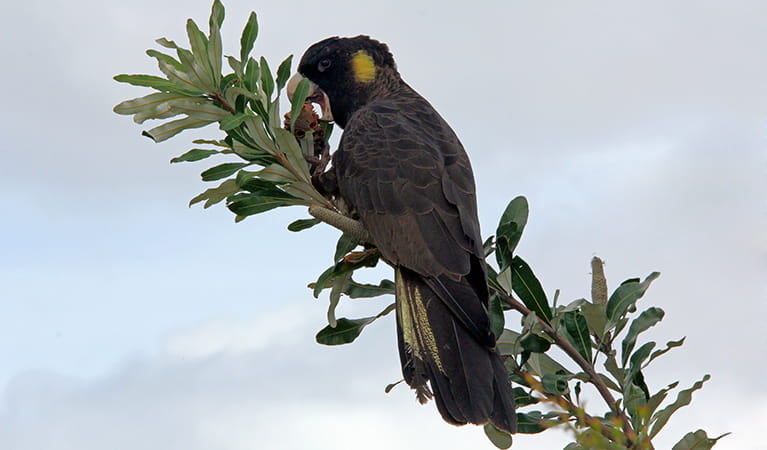
Yellow-tailed black cockatoo (Calyptorhynchus funereus)
The yellow-tailed black cockatoo is one of the largest species of parrot. With dusty-black plumage, they have a yellow tail and cheek patch. They’re easily spotted while bird watching, as they feed on seeds in native forests and pine plantations.
-
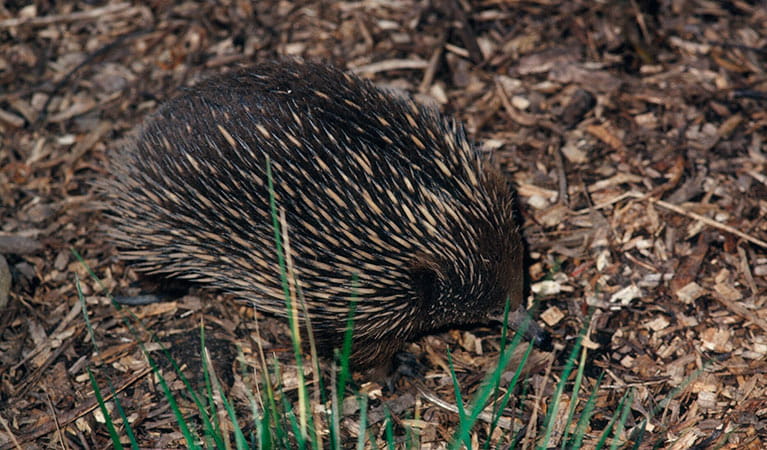
Short-beaked echidna (Tachyglossus aculeatus)
One of only 2 egg-laying mammals in the world, the short-beaked echidna is one of the most widespread of Australian native animals. Covered in spines, or quills, they’re equipped with a keen sense of smell and a tube-like snout which they use to break apart termite mounds in search of ants.
-
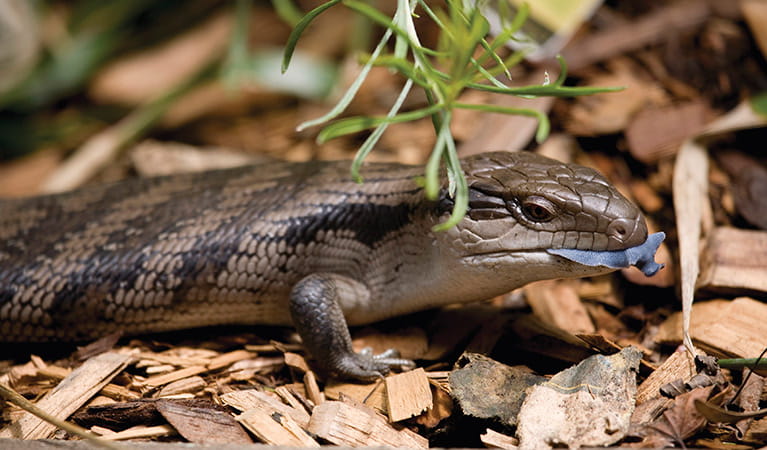
Eastern blue-tongue lizard (Tiliqua scinciodes)
The eastern blue-tongue lizard, one of the largest skinks in Australia, is found throughout most of NSW. When threatened, the eastern blue-tongue lizard displays its blue tongue in a wide-mouthed intimidating show. Not an agile animal, they feed on slow-moving beetles and snails.
Environments in this park
Education resources (1)
What we're doing
Coffs Coast Regional Park has management strategies in place to protect and conserve the values of this park. Visit the OEH website for detailed park and fire management documents. Here is just some of the work we’re doing to conserve these values:
Managing weeds, pest animals and other threats
Pests and weeds have a significant impact to the ecosystems within Coffs Coast Regional Park. Risk assessments for new and emerging weeds are carried out as an ongoing initiative within the park. Pest management of foxes and coastal weeds is a priority and an important part of the work NPWS does to protect the integrity of biodiversity which exists within Coffs Coast.
Historic heritage in our parks and reserves
The Coffs Coast has been a much-loved, beach-side holiday destination since the early 1900s. Sea and beach cultural values are recognised and valued in the park and maintained for locals and visitors.
Developing visitor facilities and experiences
Ongoing assessment and upgrades of visitor facilities within Coffs Coast Regional Park are a priority for maintenance of this park. NPWS aims to liaise with all new park neighbours for any new additions within Coffs Coast, and prioritise the signage installations to enrich the visitor experience wherever possible.
Conserving our Aboriginal culture
Protection and interpretation of Aboriginal culture and heritage is of high significance in Coffs Coast Regional Park. Working with Gumbaynggirr Aboriginal Community is a high priority, in particular with the Garlambirla Guuyu Girrwa (Coffs Harbour Elders) and Garby Elders, so that traditional knowledge is incorporated into the management of this park.
Managing fire
NSW is one of the most bushfire prone areas in the world as a result of our climate, weather systems, vegetation and the rugged terrain. NPWS is committed to maintaining natural and cultural heritage values and minimising the likelihood and impact of bushfires via a strategic program of fire research, fire planning, hazard reduction, highly trained rapid response firefighting crews and community alerts.

